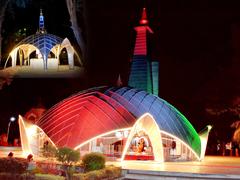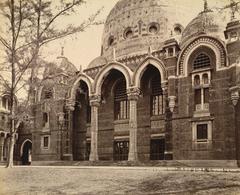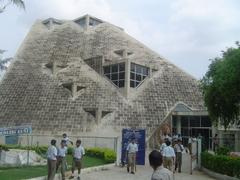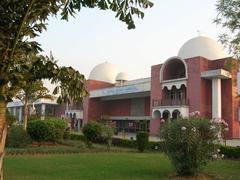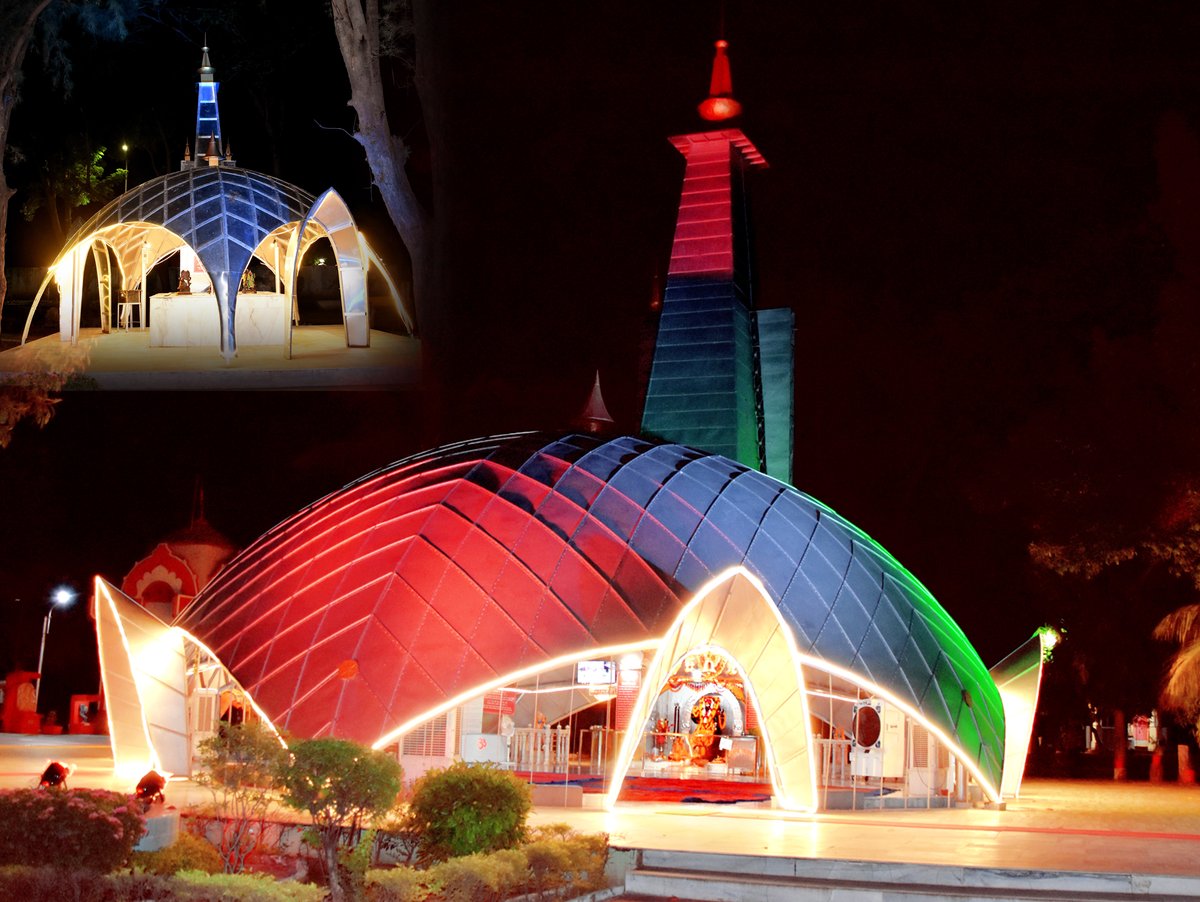
EME Temple Visiting Hours, Tickets, and Historical Information
Publication Date: 18/07/2024
Introduction to EME Temple
The EME Temple, also known as the Dakshinamurthy Temple, is a remarkable fusion of modern and traditional architectural styles located in Vadodara, Gujarat, India. Constructed in 1966 by the Electrical and Mechanical Engineering (EME) Corps of the Indian Army, the temple serves as a symbol of India’s secular ethos and cultural diversity (culturalindia.net). Designed under the visionary leadership of Brigadier A.F. Eugene, the temple transcends religious boundaries, catering to people of all faiths. Its unique geodesic structure, covered with aluminum sheets, is an architectural marvel reflecting the unity of various religions with elements from Hinduism, Christianity, Islam, Buddhism, and Jainism seamlessly integrated into its design. The temple is dedicated to Lord Dakshinamurthy, a form of Lord Shiva, revered as the universal teacher, and also houses idols of other deities, making it an inclusive place of worship (holidify.com). Beyond its architectural and religious significance, the EME Temple hosts various events and festivals, promoting interfaith dialogue and understanding. Visitors can expect a serene environment ideal for meditation and reflection, along with a rich heritage of India’s diverse cultural and religious traditions (trawell.in).
Contents Overview
- History of EME Temple, Vadodara
- Origins and Construction
- Architectural Significance
- Religious and Cultural Significance
- Visiting Hours and Ticket Information for EME Temple
- Exploring the Architectural Marvel of EME Temple
- Historical Events and Milestones
- Preservation and Conservation Efforts
- Accessibility and Amenities
- Community Engagement and Social Initiatives
- Future Prospects and Developments
- FAQ
History of EME Temple, Vadodara
Origins and Construction
Constructed in 1966 by the Electrical and Mechanical Engineering (EME) Corps of the Indian Army, the EME Temple derives its name from this corps. The temple’s design blends modern and traditional architectural styles, symbolizing the unity of different religions and cultures in India.
Architectural Significance
The EME Temple is renowned for its distinctive geodesic structure covered with aluminum sheets. This design gives the temple a futuristic appearance while serving practical purposes such as durability and ease of maintenance. The architecture represents secularism, incorporating elements from various religions, including Hinduism, Christianity, Islam, Buddhism, and Jainism. For instance, the temple’s dome is inspired by Islamic architecture, while the spire resembles a Christian cross. The entrance is designed in the shape of a Buddhist stupa, and the windows feature Jain motifs.
Religious and Cultural Significance
Dedicated to Lord Dakshinamurthy, a form of Lord Shiva revered as the universal teacher, the temple’s primary deity is depicted in a meditative pose, symbolizing wisdom and knowledge. The temple also houses idols of other deities, including Lord Ganesha, Goddess Durga, and Lord Vishnu, making it a place of worship for followers of different faiths. The inclusive design and dedication to multiple deities reflect India’s rich cultural and religious diversity, attracting visitors from various backgrounds and beliefs. The temple’s serene environment and spiritual ambiance make it a popular destination for both devotees and tourists.
Visiting Hours and Ticket Information for EME Temple
The EME Temple is open to visitors from 6:30 AM to 8:30 PM daily. There are no entry fees for visiting the temple, making it accessible to everyone. However, donations are welcomed and go towards the temple’s maintenance and charitable activities. During special events and festivals, extended hours may apply. It is advisable to check the temple’s official website or contact the temple authorities for the latest information on visiting hours and events.
Exploring the Architectural Marvel of EME Temple
Visitors to the EME Temple can expect a unique and enriching experience, combining spiritual, cultural, and architectural elements. The temple’s main sanctum, surrounded by lush gardens and a serene meditation hall, provides an ideal setting for reflection and meditation. The well-maintained premises enhance the visitors’ experience, offering a tranquil environment to explore the temple’s various features.
Historical Events and Milestones
Since its inception, the EME Temple has been a site of numerous significant events and milestones. One of the most notable events in the temple’s history is its consecration ceremony, which was attended by prominent religious leaders and dignitaries from across the country. The temple has also hosted various cultural and religious festivals, including Maha Shivaratri, Navaratri, and Diwali, drawing large crowds of devotees and tourists. In recent years, the temple has undergone several renovations and upgrades to enhance its facilities and accommodate the growing number of visitors.
Preservation and Conservation Efforts
The EME Temple is not only a place of worship but also a heritage site requiring ongoing preservation and conservation efforts. The Indian Army, along with local authorities and heritage organizations, has undertaken various initiatives to maintain the temple’s structural integrity and aesthetic appeal. These efforts include regular maintenance, restoration of damaged elements, and implementation of sustainable practices to ensure the temple’s longevity.
Accessibility and Amenities
The EME Temple is easily accessible by road, with ample parking facilities available for visitors. The temple is located approximately 6 kilometers from Vadodara Railway Station and 10 kilometers from Vadodara Airport, making it convenient for both local and out-of-town visitors. Public transportation options, such as buses and auto-rickshaws, are also available for easy access to the temple. The temple premises are equipped with various amenities to ensure a comfortable and enjoyable visit, including clean restrooms, drinking water facilities, and seating areas. The temple also has a souvenir shop where visitors can purchase religious items, books, and memorabilia related to the temple and its history.
Community Engagement and Social Initiatives
The EME Temple is actively involved in various community engagement and social initiatives, reflecting its commitment to social responsibility and service. The temple authorities organize regular health camps, educational programs, and charitable activities to support the local community and promote social welfare. These initiatives include free medical check-ups, distribution of educational materials, and support for underprivileged families. The temple also collaborates with local schools, colleges, and non-profit organizations to promote cultural and educational activities.
Future Prospects and Developments
Looking ahead, the EME Temple aims to continue its legacy of spiritual and cultural enrichment while embracing modern advancements and sustainable practices. The temple authorities have outlined plans for further development and expansion, including the construction of additional facilities, enhancement of existing infrastructure, and implementation of eco-friendly initiatives. These future developments are aimed at enhancing the visitor experience, preserving the temple’s heritage, and promoting its significance as a symbol of unity and harmony.
FAQ
What are the EME Temple visiting hours?
- The EME Temple is open from 6:30 AM to 8:30 PM daily.
How much are the tickets for EME Temple?
- There are no entry fees for visiting the EME Temple.
What is the best time to visit the EME Temple?
- The temple can be visited throughout the year. However, it is especially vibrant during festivals like Maha Shivaratri, Navaratri, and Diwali.
Conclusion
In summary, the EME Temple in Vadodara stands as a testament to India’s rich cultural and religious diversity, blending modern architectural elements with traditional symbolism to create a unique and inclusive place of worship. Open to visitors from 6:30 AM to 8:30 PM daily, the temple offers a serene and enriching experience for both devotees and tourists. The temple’s history, dating back to its construction in 1966 by the EME Corps of the Indian Army, highlights its significance as a symbol of unity and secularism in India. The EME Temple not only serves as a spiritual and cultural hub but also actively engages in social initiatives, reflecting its commitment to community welfare and social harmony. With its well-maintained premises, accessible facilities, and various amenities, the EME Temple provides a comfortable and enriching visit for all. As it continues to evolve with modern advancements and sustainable practices, the EME Temple remains a beacon of spiritual and cultural inspiration, promoting unity and harmony among people of different faiths (tripadvisor.in, tourmyindia.com).
